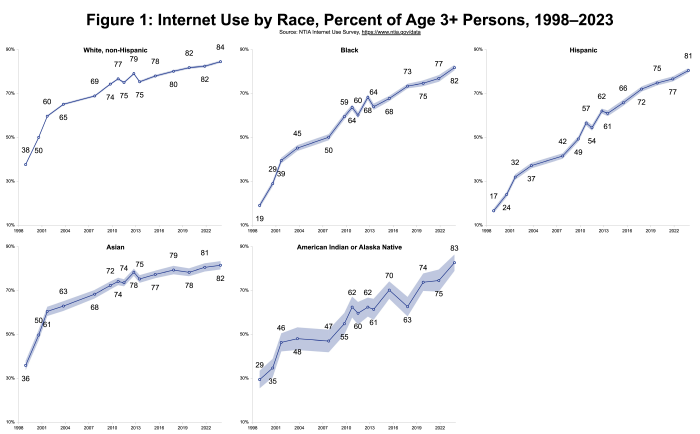New NTIA Data Show 13 Million More Internet Users in the U.S. in 2023 than 2021
By Rafi Goldberg, Senior Policy Advisor, Digital Equity
Results from the latest NTIA Internet Use Survey point to significant progress toward achieving Internet for All, as 13 million more people used the Internet in the United States in 2023 compared with just two years earlier.
Working to achieve digital equity in the United States has long been at the core of NTIA’s mission. Whether we’re implementing vital programs to improve availability, adoption, and meaningful use of the Internet, advocating for policies that make modern technologies more accessible to all Americans, or promoting digital equity, NTIA is committed to enabling widespread use of the Internet for communicating, learning, sharing ideas, and growing the economy.
To reach this goal, we need solid, evidence-backed research to inform policies and programs. That’s why NTIA began working with our colleagues at the Census Bureau on the NTIA Internet Use Survey 30 years ago this summer.
The latest edition of this vital survey, fielded in November 2023, provides valuable insights into both the progress we’ve made and the challenges that remain.
While we have data from dozens of questions to explore, we have found much to celebrate in our initial analysis:
- 83 percent of people ages 3 and older in the United States used the Internet in some fashion in 2023, compared with 80 percent in 2021. That’s the largest increase since the 2015-2017 period.
- These gains came in large part from segments of the population that historically have been more likely to find themselves on the wrong side of the digital divide. For example, 83 percent of American Indians and Alaska Natives used the Internet in 2023, up from 75 percent in 2021.
- Internet adoption also increased among those in lower-income households, from 69 percent in 2021 to 73 percent in 2023 among those in households making less than $25,000 per year (see Figure 2).
- 72 percent of people lived in households with both fixed and mobile Internet connections in 2023, up from 69 percent in 2021.
- Just 12 percent of people lived in households without any Internet connection in 2023, compared with 14 percent in 2021.

While this progress is encouraging, the data also shows where challenges and disparities remain on the path to digital equity:
- Despite significant gains, persons in lower-income households remained considerably less likely than their higher-income counterparts to have both fixed and mobile connections and were more likely to either have no household connections or be mobile-only.
- 80 percent of people in households making $100,000 or more per year had both fixed and mobile connections.
- Only 54 percent of those in households making less than $25,000 had both (see Figure 3).
- Some Americans were substantially less likely to have a desktop, laptop or tablet, than others.
- 72 percent of White non-Hispanics and 71 percent of Asians used a desktop, laptop or tablet in 2023.
- But only 62 percent of Black Americans, 57 percent of American Indians and Alaska Natives, and 54 percent of Hispanics used a desktop, laptop or tablet.
- Those same groups are also much more likely to rely entirely on a smartphone for their Internet access:
- 25 percent of Hispanics are smartphone only users, as well as
- 22 percent of American Indians and Alaska Natives, and
- 16 percent of Black Americans.
- That’s compared with 12 percent each of White non-Hispanics and Asians.
The disparities we find when looking beyond overall Internet use suggest that, while our country is making great strides toward getting everyone online in some fashion, the quality and experience of connectivity still varies greatly. NTIA’s Internet for All programs are designed not only to expand Internet access, but to ensure everyone in America can thrive online with affordable service, suitable devices and the digital skills needed for success.
There is much more to explore in the latest NTIA Internet Use Survey data, and we will continue to publish our findings over the next several months. We have also updated NTIA’s Data Explorer tool with the latest estimates for every metric—including not just basic Internet use but also technologies, devices, online activities, and other important data—to enable interested users to visualize results from the 2023 NTIA Internet Use Survey. We will soon post the complete 2023 dataset, along with extensive documentation and sample code, so that the research community can perform its own studies using this data collection.
Finally, we’re excited to say that there are more developments on the horizon. The 30th anniversary of the NTIA Internet Use Survey is not just a milestone to celebrate—though we will certainly be doing that throughout the next year—but also an opportunity to develop new data products that will inform digital equity policy for many years to come. Stay tuned by signing up for NTIA’s Data Central mailing list.
